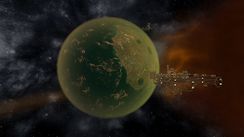
|
This wiki is closed in favour of the new wiki. Information shown is likely to be very out of date. |
Planet Columbia
| Planet Columbia | |
| Owner | |
| Location | 7E, Virginia |
| Technical information | |
| Population | Classified |
| Docking | unknown |
| Terrain | Terrestrial |
| Diameter | 12,753 km |
| Mass | 5.98 x 10e24 kg |
| Temperature | -46°C to 23°C |
| Escape velocity | 8.27 km/sec |
Columbia is rather frigid for a terrestrial world, but it is capable of supporting human life. It has a relatively thin atmosphere and low gravity, which has given rise to numerous large flying species, many of which are predatory carnivores. Its flora has evolved to immense sizes, with shrubs standing as tall as 20 meters, and forests easily towering upwards of 500 meters, yet still have flexible trunks. These are major hazards to landing craft and surface teams.
Nevertheless, Liberty colonized Columbia. Its inhospitable nature gives it an excellent natural barrier against infiltration, so it was given to the Liberty Navy, in order to establish a secure facility on the surface. Liberty built a single, massive pyramid-shaped complex on the surface. Nicknamed the "Chayenne Mountain Complex" (partly to throw off foreign infiltrators so they would investigate the planet's mountain ranges) it houses the bulk of the Liberty Navy strategic command staff, and can serve as a point-of-retreat for the Liberty government in case Manhattan were ever to be threatened.
The Chayenne facility is protected by a powerful shield grid which draws power directly from the planet's mantle - effectively rendering it immune to orbital bombardment so long as the planet itself remains intact. Beyond that the planet has little of value. What resources it does posess are inaccessible due to the extremely hazardous ecology, and restricted nature of the Virginia system as a whole.
